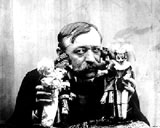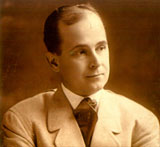影片对白 Woo Hoo bars they ain't, but they take you back. You know? Remind you of home. Sweet, salty home.
文化面面观
早期动画名人
一个新事物的出现总是经过无数人的努力,动画也是如此。
There is no single person who can be considered the "creator" of the art of animation, as there were several people doing several projects which could be considered various types of animation all around the same time. (Short, hand-drawn animation scenes could be presented with the Phenakistoscope, the Zoetrope, and other optical "toys" already in the early 1800s.)
The following is a brief listing on those who are often acknowledged as significant to the development of animation. Note that this list is by no means a comprehensive list of contributors to early animation.

Georges Méliès
was a creator of special effect films, such as A Trip to the Moon. He used many techniques – one of which was to stop the camera rolling, change something in the scene, and then continue rolling the film. This is a very similar idea to that of stop-motion animation. Méliès accidentally happened upon the technique when his camera broke down while shooting a bus driving by. When the camera was fixed, a horse happened to be passing by just as Méliès continued to film. The result was that the bus appeared to change into a horse.

J. Stuart Blackton
was possibly the first filmmaker in America to use the techniques of stop-motion and hand-drawn animation. Introduced to filmmaking by Edison, he pioneered these concepts at the turn of the 20th century, with his first copyrighted work dated 1900.

Émile Cohl
began drawing cartoon strips and created a film in 1908 called Fantasmagorie. The film largely consisted of a stick figure moving about and encountering all manner of morphing objects, such as a wine bottle that transforms into a flower. There were also sections of live action where the animator’s hands would enter the scene. The film was created by drawing each frame on paper and then shooting each frame onto negative film, which gave the picture a blackboard look.

Winsor McCay
created detailed animations that required a team of artists and painstaking attention for detail. Each frame was drawn on paper, requiring backgrounds to be redrawn, as well characters to be animated. His films such as Gertie the Dinosaur (1914) and The Sinking of the Lusitania (1918) were of an impressive scale, although The Sinking of the Lusitania used cels.
Otto Messmer
in 1919, created the character of Felix the cat for Pat Sullivan's animation studios. The importance of Felix lies in the character's strong personality, created largely through gesture and actions.
考考你
用今日所学将下面的句子译成英语。
1. 一辆车碾了她的猫,使得她嚎啕大哭。
2. 那个在盯着我们的人很可能在观察我们。
3. 把你的衬衣掖进去,垂在长裤外面很不好。
Open season《丛林大反攻》精讲之四 考考你 参考答案
McSquizzy: Hi! Lost your way to Sunday school, pal? This is McSquizzy's turf. Nobody messes with McSquizzy. Because that's me.
麦克斯奎奇:嘿!去主日学校迷路了吗,小家伙?这是麦克斯奎奇的地盘。谁也别来烦扰麦克斯奎奇。我就是麦克斯奎奇。
Boog: What?
布格:什么?
McSquizzy: Touch a needle in this tree and I'll give you such a doing!
麦克斯奎奇:你敢碰这棵树一下,我就让你尝尝这个!
Boog: Yeah? You and what army? Oh, that army.
布格:是吗?你和谁一伙啊?哦,他们啊。
影片对白 Woo Hoo bars they ain't, but they take you back. You know? Remind you of home. Sweet, salty home.
点击进入:更多精彩电影回顾
(英语点津Annabel编辑)